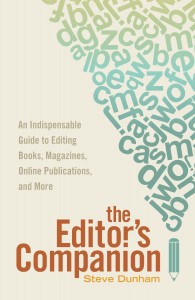When I first read the title of this book, I thought it would be a comprehensive “how to” guide for people learning how to edit, like The Copyeditor’s Handbook by Amy Einsohn. The focus of this book is somewhat different. The Editor’s Companion is aimed at professionals who already know something about communications, but are early on in their careers as editors. Dunham has more than 30 years of writing and editing experience, and he shares his experience on critical topics to help other editors understand the role and avoid some common pitfalls.
 The strength of this book lies in Dunham’s descriptions of his personal editing experiences. He includes many examples from documents he has edited and often points out alternative solutions. I particularly enjoyed his chapter on “Editing for Precise Language,” which includes thoughtful insights on accuracy, word choice and proper attribution. Dunham also talks about practical tips and tricks, such as identifying a list of “bad words” that are difficult to spot (like mange for manage). He provides a copyediting and proofreading checklist and a list of helpful resources.
The strength of this book lies in Dunham’s descriptions of his personal editing experiences. He includes many examples from documents he has edited and often points out alternative solutions. I particularly enjoyed his chapter on “Editing for Precise Language,” which includes thoughtful insights on accuracy, word choice and proper attribution. Dunham also talks about practical tips and tricks, such as identifying a list of “bad words” that are difficult to spot (like mange for manage). He provides a copyediting and proofreading checklist and a list of helpful resources.
In addition to his detailed thoughts on copy editing, Dunham touches on topics relating to substantive and stylistic editing, such as knowing your audience and focusing on the subject. I found these sections to be a little thin on content. Dunham provides many quotes here from other expert sources; I would have preferred to hear more about his own thoughts and approaches. The book in general is organized as a collection of short observations on specific topics of interest, which sometimes affects the coherency of the overall narrative.
Dunham ends the book with the chapter “The Ones That Got Away,” where he provides many fun examples of editorial misses (like the ones Editors Canada calls out every year for our Oops Awards). Dunham displays a great sense of humour in this chapter. If you’d like to see more of these gaffes, he writes about them on his Editor’s Companion blog.
I believe The Editor’s Companion would be an interesting read for other copy editors, particularly for those working with non-fiction. Although this is not a comprehensive guide on all aspects of editing, it works well as a supplementary resource and includes some great advice from an experienced editor.
If you have read this book, what did you think? What would you recommend as an editing resource for new editors?
This book was provided to The Editors’ Weekly free of charge by the publisher. Neither The Editors’ Weekly nor the reviewer received any compensation for this review. The opinions contained in this review are those of the reviewer alone and were written free of any obligation or agreement with the publisher.
The Editors’ Weekly is the official blog of Editors Canada. Contact us.
Discover more from L'HEBDOMADAIRE DES RÉVISEURS
Subscribe to get the latest posts sent to your email.
